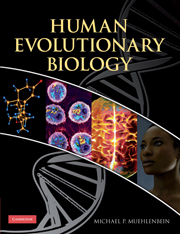Book contents
- Frontmatter
- Contents
- List of contributors
- Preface
- Part I Theory and Methods
- 1 Evolutionary Theory
- 2 The Study of Human Adaptation
- 3 History of the Study of Human Biology
- 4 Genetics in Human Biology
- 5 Demography
- 6 History, Methods, and General Applications of Anthropometry in Human Biology
- 7 Energy Expenditure and Body Composition: History, Methods, and Inter-relationships
- 8 Evolutionary Endocrinology
- 9 Ethical Considerations for Human Biology Research
- Commentary: a Primer on Human Subjects Applications and Informed Consents
- Part II Phenotypic and Genotypic Variation
- Part III Reproduction
- Part IV Growth and Development
- Part V Health and Disease
- Index
- References
1 - Evolutionary Theory
Published online by Cambridge University Press: 05 August 2012
- Frontmatter
- Contents
- List of contributors
- Preface
- Part I Theory and Methods
- 1 Evolutionary Theory
- 2 The Study of Human Adaptation
- 3 History of the Study of Human Biology
- 4 Genetics in Human Biology
- 5 Demography
- 6 History, Methods, and General Applications of Anthropometry in Human Biology
- 7 Energy Expenditure and Body Composition: History, Methods, and Inter-relationships
- 8 Evolutionary Endocrinology
- 9 Ethical Considerations for Human Biology Research
- Commentary: a Primer on Human Subjects Applications and Informed Consents
- Part II Phenotypic and Genotypic Variation
- Part III Reproduction
- Part IV Growth and Development
- Part V Health and Disease
- Index
- References
Summary
Our contemporary understanding of evolutionary processes builds on theory developed during the “Evolutionary Synthesis” of the 1930s and 1940s, when Darwin's ideas, especially on natural selection, were joined with Mendelian genetics. Since, then, of course, our understanding of evolution has been greatly advanced by the discoveries in molecular genetics, as well as by continuing elaboration of the “neo-Darwinian” theory that issued from the Evolutionary Synthesis (Futuyma, 1998, 2009).
A capsule summary of contemporary theory, to be followed by more detailed explication, is as follows. Elementary evolutionary change consists of changes in the genetic constitution of a population of organisms, or in an ensemble of populations of a species. These genetic changes may be reflected in change of the population mean or variance of phenotypic characteristics. Any change requires that genetic variation originate by mutation of DNA sequences, and/or by recombination. The minimal evolutionary process is an increase in the frequency of a mutation, or a set of mutations, within a population, and the corresponding decrease in frequency of previously common alleles. Such frequency changes are the consequence of random genetic drift (leading to occasional fixation of nearly neutral genetic variants) or of diverse forms of natural selection. Successive such changes in one or more characteristics cumulate over time, yielding potentially indefinite divergence of a lineage from the ancestral state. Different populations of a species retain similarity due to gene flow and perhaps uniform selection, but can diverge due to differences in mutation, drift, and/or selection.
- Type
- Chapter
- Information
- Human Evolutionary Biology , pp. 3 - 16Publisher: Cambridge University PressPrint publication year: 2010
References
- 55
- Cited by

